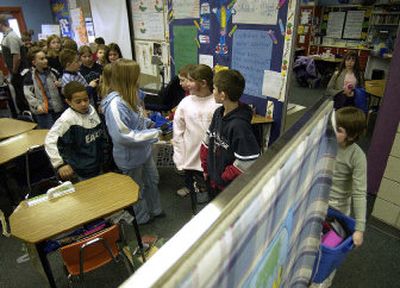Closing in on learning

In 1979, Ponderosa Elementary School was on the cutting edge of elementary school design.
Following an education trend sweeping the nation, the Central Valley school was built without walls, hallways or classroom doors.
“We felt like we were in a fishbowl,” said 28-year veteran Ponderosa teacher Marilyn Mraz. “People were coming by all the time to see how this was working.”
Central Valley built five open-concept schools from 1970 to 1980, also known as the “schools without walls.”
But like 1970s bell-bottom trousers and 1980s acid-washed jeans, the fad quickly went by the wayside, and the district is now seeking a voter-approved bond to put up walls in at least two of those schools to create traditional classrooms that serve every learner.
“There’s definitely more noise in an open-concept plan,” said Dave Jackman, director of auxiliary services for Central Valley. “It does not work well for all children in terms of learning.”
Open-concept schools were popping up in districts all over the United States during the late 1960s and early 1970s as educators embraced a concept known as the “open classroom,” a groovy new way of teaching that encouraged teaming and collaboration, where teachers taught multiple classes of kids at a time. While one teacher taught science to three classes of third-graders, another might teach reading in the same space.
Educators said the open-concept design allowed for small learning centers throughout the classroom, where students could feel free to be independent, creative self-educators. It was thought that rearranging furniture and designing buildings to be completely “open” furthered the cause.
But studies proved otherwise.
“Open education produced a host of problems, including unruly classes, kids wandering around wondering what they should do next,” said education historian Diane Ravitch, a New York University educator and Brookings Institution fellow. “Teachers found that they could not teach when there were four classes in the same space, with no walls.”
Central Valley’s open-concept schools first sprang up in the district in 1970 with the construction of Keystone Elementary. The building is now a multiuse educational center that houses several programs, including a home-school cooperative and early childhood education center.
Chester Elementary School followed in 1974, then Greenacres in 1978, Ponderosa in 1979, and finally Sunrise in 1980.
The Deer Park School District north of Spokane built one but gave it up for a new school with walls a few years back. The district now uses the old building for office space and as a base for the district’s home-school cooperative.
Central Valley’s five open-concept schools have never had major remodels, except for a few walls for computer labs, which didn’t exist in the 1970s.
The teachers make it work because they have to, and some are still happy to work closely with other teachers.
“It was kind of like a finely tuned V-8 engine, really no different than a large open office,” said Jay Walter, a former Central Valley administrator who was once the principal at Ponderosa and a proponent of the concept. “The communication really opened up. If I had the choice between a traditional closed classroom and an open one, I’d go to the open one.”
But not all teachers agree.
Some started erecting bookshelves and cupboards in the place of walls as soon as they moved into the buildings.
“It didn’t take long,” said Terry Ellifritz, the principal at Greenacres Elementary School, who also taught at Chester.
An open environment also became obsolete because the focus turned to standardized testing and more specific learning goals for each grade level.
“Everything was kind of jointly taught back then,” Ellifritz said. “Teachers just don’t teach that way any longer.”